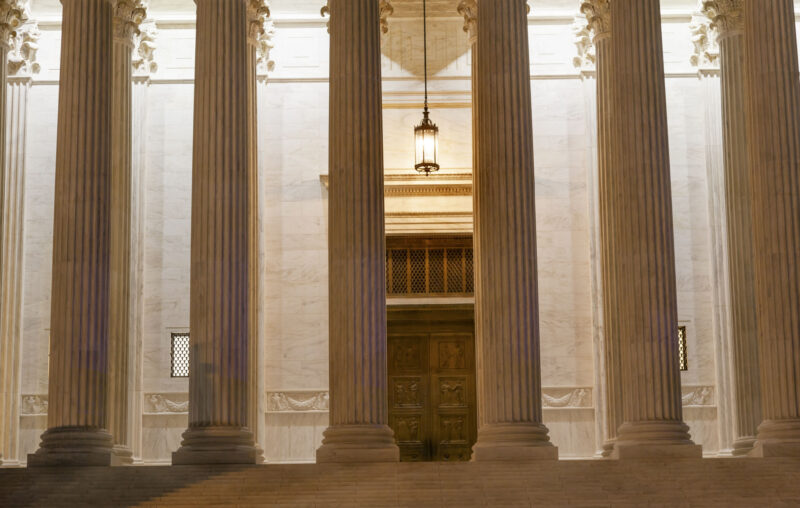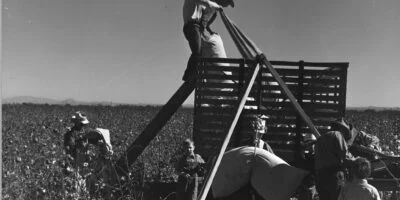The Supreme Court’s Complicity in Our Loss of Freedom

After the Constitution had been drafted, it was submitted to the states for ratification. It had quite a few opponents, called the Anti-Federalists. They argued that the proposed government would have too much power and would become a danger to the people’s rights. Most of their fire was aimed at Articles I and II, which created the legislative and executive branches, but some Anti-Federalists also expressed fears that the judiciary in Article III could become a menace. Seeking to allay all such fears, the Constitution’s proponents wrote 85 essays known as The Federalist Papers.
In Federalist 78, Alexander Hamilton defended the judiciary, calling it “the least dangerous branch” since it would have neither the legislature’s control over spending nor the executive’s power of enforcement. Hamilton argued that judicial review, the ability of a court (in this case the Supreme Court) to invalidate legislation passed by a legislature (in this case Congress) posed no threat to the rights of Americans, but was essential in protecting them against possible encroachments by the political branches.
So how has judicial review worked out?
That’s the question addressed by Hillsdale history professor Paul Moreno in his new book How the Court Became Supreme: The Origins of American Juristocracy. He provides readers with a comprehensive history of the concept of judicial review, beginning in England in the 17th century and through to the latest developments in the US Supreme Court. Moreno’s conclusion is that judicial review was a good idea but has gone terribly awry. Rather than protecting our rights under the Constitution, the Court has chosen to turn a blind eye to violations of ones it doesn’t regard as “fundamental,” and has at the same time created pseudo-rights that require coercion against peaceful people. It has been, all in all, a failure.
In the US, the history of judicial review traditionally begins with the famous 1803 case Marbury v. Madison. (Actually, there were a few obscure cases where courts declared laws unenforceable prior to Marbury, as Moreno’s deep research shows.) In Marbury, Chief Justice John Marshall ruled that Congress had unconstitutionally enlarged the Supreme Court’s original jurisdiction (cases that could be brought directly to it) in the Judiciary Act of 1791, and for that reason William Marbury, a last-minute appointment as a Justice of the Peace by President Adams, could not receive the writ of mandamus he sought to compel Secretary of State James Madison to deliver his commission. While he was legally entitled to his office, he had brought his case to the wrong court.
Marbury never pursued the matter, indicating that the case was set up to allow Marshall to declare that the Supreme Court was empowered to declare laws not in accordance with the Constitution to be null and void. How important was Marbury? Moreno argues that far too much is made of it. The case was scarcely mentioned for many decades afterwards and was perfectly in line with the thinking of most of the Founders. And it did not infringe on the rights of the people.
Throughout John Marshall’s long tenure, the Court strongly upheld property and contract rights, greatly aiding the nation’s economic development. In 1824, in Gibbons v. Ogden for example, the Court struck down a New York monopoly granted to Robert Fulton to run steamboats on the Hudson River. Congress alone had the authority to regulate interstate commerce, and state acts that interfered with commerce were unconstitutional, Marshall held. The Court was protecting freedom.
After the Civil War, however, the Court began to turn away from using judicial review to protect freedom and instead approved laws that whittled away at it. In the Slaughterhouse Cases (1873), the Court upheld a monopoly that Louisiana had granted to a cattle slaughtering business in New Orleans against a charge that doing so violated the rights of other businesses under the 14th Amendment. Ratified in 1868, the 14th Amendment was intended to make permanent the Civil Rights Act of 1866, protecting recently freed Blacks against discriminatory legislation. But the language of the 14th Amendment was racially neutral, protecting all citizens against state laws that deprived them of life, liberty, or property without due process of law, abridged the privileges or immunities of citizenship, or deprived them of equal protection of the laws. So was a state monopoly a violation of the rights of the other butchers in New Orleans?
The Court said no, declaring that the 14th Amendment only applied to the “privileges or immunities” of US citizenship, not state citizenship. Therefore, this piece of special-interest legislation was allowed to stand, despite a passionate dissent from Justice Stephen Field, who argued that “the right of free labor” was among the rights that the 14th Amendment was written to protect. Mistakenly, the Court neglected its duty to strike down a special-interest law that took freedom away from some citizens.
In a similar vein, in 1876 the Court approved a state law fixing prices for grain elevators in Munn v. Illinois. It was permissible, the majority held, for the state to take away the freedom of a business to set prices for its services where the property was “affected with the public interest.” Again, special-interest politics (the farm lobby wanted the state to limit prices for grain storage) won out and the Court wasn’t troubled by the consequent erosion of liberty.
Even in that era, the Court was sometimes inclined to rule against state coercion and in favor of liberty. The most famous case was Lochner v. New York (1905), where, in a 5-4 decision, the Court held that a statute that set a maximum number of hours bakers could work during a week was a violation of the 14th Amendment, which protected liberty of contract. In a famous dissent, Justice Holmes complained that “the 14th Amendment does not enact Mr. Herbert Spencer’s Social Statics.” Of course not, but it was meant to defend people’s freedom against having a choice as basic as how much to work taken away by government edict.
Law professors almost invariably ridicule Lochner as a bad decision where the justices imposed their values to override the democratic process. That’s the wrong way to look at it. They were safeguarding an individual’s freedom against encroachment by the state, a proper application of judicial review.
During this time period, some decisions struck down laws that took freedom away, giving rise to the mistaken notion of a “laissez-faire” Court. That’s mistaken because, as Moreno shows, there were also cases where the Court allowed governments to get away with highly illiberal policies, most notably the eugenics case Buck v. Bell in 1927.
From the cases the “progressives” lost, however, they drew a lesson: concentrate on using law schools to train future lawyers to think the progressive way, and staff the courts with judges who were favorable to the use of government power to accomplish social and economic transformation.
In that, they were highly successful. An early breakthrough came in 1916 when President Wilson nominated Louis Brandeis for an empty seat on the Court. Brandeis was a progressive who would become known for what legal scholars and his fellow justices called “Gefuhlsjurisprudenz” – German for “jurisprudence by sentiment.” To Brandeis, getting the desired outcome meant far more than the letter of the law.
After the Great Depression hit, the Court was faced with a series of cases in which government power was employed to supposedly fix the nation’s troubles. Initially, the Court was content to approve such measures. In Nebbia v. New York (1934), the Court upheld a state regulation of the price of milk where a merchant was fined for selling milk below the mandated price. And in Home Building and Loan v. Blaisdell (1934) the Court approved of a Minnesota law putting a moratorium on mortgage foreclosures. All the old concern over property rights and freedom of contract had been swept away with the “progressive” tide. Such measures did nothing to stem the Depression, but they did undermine the Constitution and individual freedom.
Then in 1935, several cases involving federal legislation came to the Court and it struck them down on the grounds that Congress had exceeded its authority. In Schechter Poultry v. US, the Court held that Congress had impermissibly delegated regulatory authority to bureaucrats, and thus the National Industrial Recovery Act was unconstitutional. After that and several other reversals, President Roosevelt was furious. Following his landslide re-election in 1936, he proposed his plan to “pack” the Court with six new justices who would, of course, all be sympathetic to his goals.
Although the court-packing legislation ran into stiff opposition among congressional Democrats and never advanced, it nevertheless had an effect on two members of the Court, Chief Justice Charles Evans Hughes and Justice Owen Roberts, who in 1937 sided with the government in cases such as National Labor Relations Board v. Jones & Laughlin Steel where the issues were no different than in the 1935-36 cases. In Jones & Laughlin, the issue was the legitimacy of the National Labor Relations Act, which trampled upon employer property rights, contractual freedom, and even freedom of speech in its objective of aiding unionization. Constitutional liberties were again sacrificed on the altar of politics, exactly as the Founders had feared.
And then things got even worse.
In 1938, a case came to the Court named United States v. Carolene Products Co. The dispute was over a federal law, the Filled Milk Act, which prohibited the sale of “adulterated” milk products. Carolene had sold a product that blended coconut oil with condensed milk. This was more special interest legislation, the dairy lobby’s seeking to use the government to stifle competition. Would the Court approve?
Yes, but more than that, Chief Justice Stone added a famous footnote stating that the Court would employ different standards of review depending on the type of case. It would presume constitutionality for “mere” business regulations, but would scrutinize cases involving “fundamental rights” or the interests of minority groups. Nothing in the wording of the Constitution indicates that some rights are superior to others, nor that some Americans deserve more protection than others. But the Court had spoken and thereafter, it and other courts would rubber-stamp any federal or state law that regulated business or property, so long as legislators might have had some rational basis for it.
The most egregious example of this judicial mindset came in the 1942 case Wickard v. Filburn. Federal regulations prescribed how much wheat farmers were allowed to grow in pursuit of higher prices. (One of the beliefs of the New Dealers is that higher agricultural prices would somehow restore general prosperity.) An Ohio farmer was penalized for having grown more wheat than he was allowed to. He argued that even if trying to raise the price of wheat were a valid use of federal power, he had consumed all of the wheat on his own farm and therefore no interstate commerce was involved. Since congressional power only extended to interstate commerce, the regulation couldn’t apply to him. But the Court found an ingenious response to crush his right to use his own property as he saw fit: if he hadn’t grown more than his permitted amount of wheat, he might have had to purchase wheat that could have come through interstate commerce, and thus his action affected the price of wheat.
Property rights and freedom of contract had been read out of the Constitution by “progressive” justices who thought they knew which rights were truly important and which ones weren’t.
Could matters get worse? Yes—in the 1950s, we had the Warren Court.
Under Chief Justice Earl Warren, the Court strode much further into judicial supremacy. Warren was noted for caring little about what the law actually said and focusing on what was “fair.” His first big decision was Brown v. Board of Education, declaring “separate but equal” public schools unconstitutional. Among the country’s elites, the outcome was very popular, but many legal scholars who applauded it nevertheless found the legal reasoning weak. Warren and his allies were soon joined by William Brennan, who loved the idea of using the Court to push progressive policy ideas. In the early 1960s, it waded into what had always been regarded as a political question when it declared that state legislatures must be apportioned equally. It also changed criminal procedure, mandating that courts use the exclusionary rule to void any evidence obtained in violation of the defendant’s rights. The Court was now making policy, not just reviewing constitutionally questionable laws, exactly what the Anti-Federalists had feared.
Warren retired in 1969, and President Nixon replaced him with Warren Burger, a judicial conservative who was expected to steer the Court away from activism. Things didn’t work out that way.
One of Burger’s first major decisions was Griggs v. Duke Power (1971) where he expanded the Equal Employment Act to say that business testing that had a “disparate impact” on protected minority groups was illegal. Civil rights advocates were amazed, and said that they didn’t think Burger knew what he had accomplished for them.
Then in 1973, Nixon’s second appointment, Justice Harry Blackmun, authored the decision in Roe v. Wade, where the Court made abortion policy for the entire nation. Again, the result met with favor among elites who had come to see the Court as the conscience of the nation, but the decision was widely denounced by friends and foes alike. Yale law professor John Hart Ely wrote that Roe “was not constitutional law and gives almost no sense of an obligation to try to be.”
Another signal failure of judicial review in recent decades has been the Court’s deferential attitude toward the administrative state, those numerous bureaucracies that effectively govern much of our lives. As noted above, the Court had looked with favor on the agencies since the New Deal, but in the 1984 case Chevron v. Natural Resources Defense Council, it declared that such agencies should be given deference with regard to the scope of their authority. In other words, the bureaucrats were to be presumed correct in their interpretation of their power. The result was mushrooming administrative regulation.
The US certainly is suffering from, as Moreno puts it, “juristocracy.” Too many of the former and present members of the Court think of themselves as the nation’s conscience, but they have a great number of sins, both of commission and omission, to atone for.










